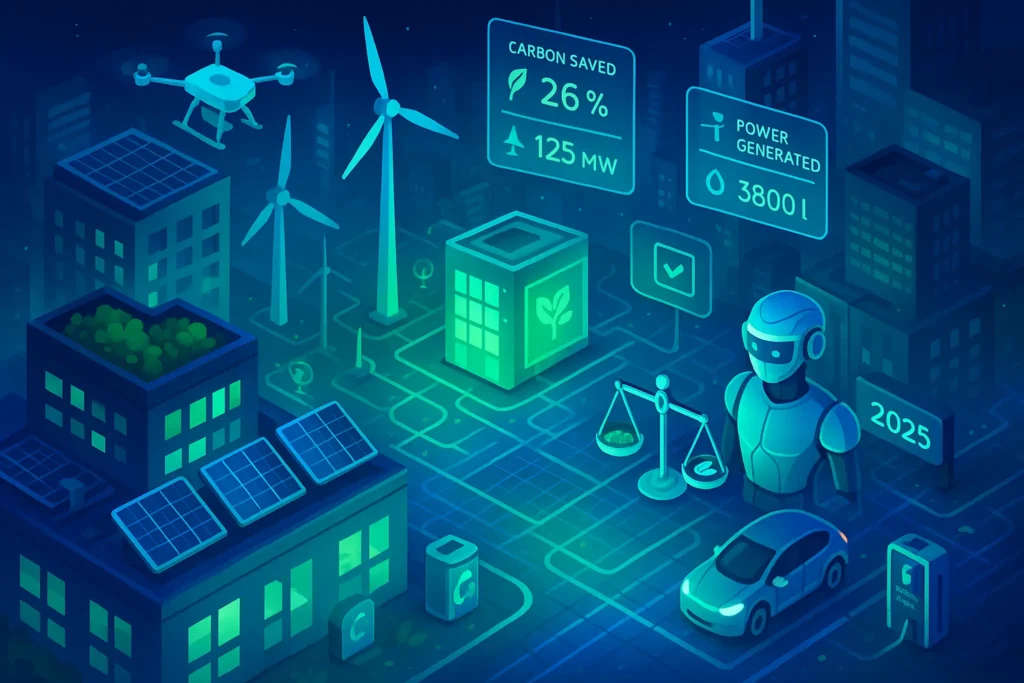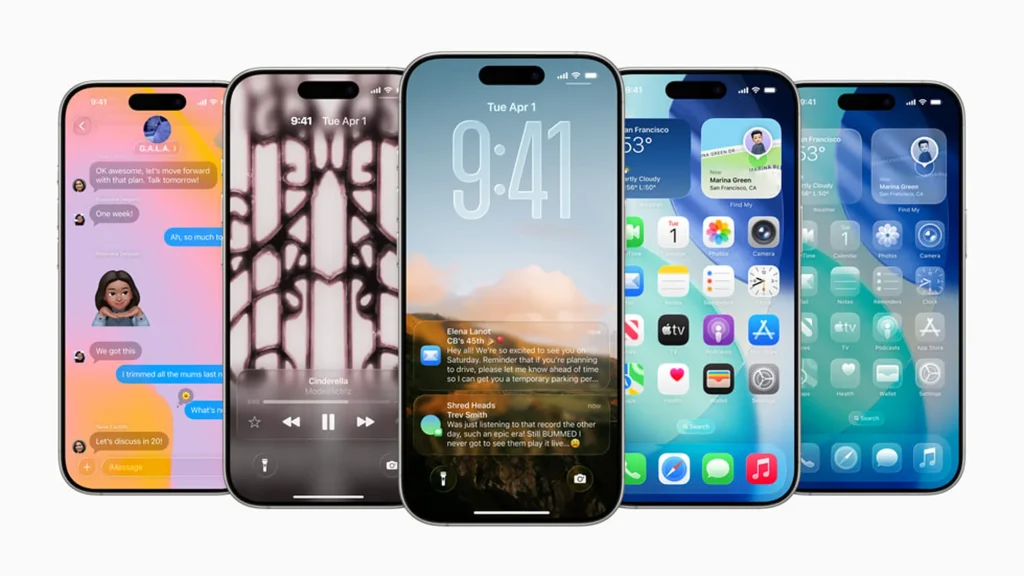-This post may contain affiliate links. If you click on one and make a purchase, I may earn a small commission at no extra cost to you.-
🌍 Intro: The Climate Tech Frontier
Electric cars. Solar-powered data centers. Carbon-sucking machines. In 2025, climate change isn’t just a problem for scientists or activists—it’s a battleground for engineers, startups, and tech giants alike.
The question isn’t whether tech can help save the planet—it’s how, where, and how fast.
In this post, we spotlight the green tech breakthroughs that are reshaping our world today and show you how innovations in clean energy, consumer electronics, corporate strategies, and startups are building a more sustainable future.
🌱 1. Clean Energy Breakthroughs
Energy is the beating heart of sustainability—and in 2025, some heart-pounding progress is happening.
Beyond solar and wind, hydrogen fuel is re-emerging as a clean energy contender. In 2025, multiple countries—like Japan, Germany, and Saudi Arabia—have launched green hydrogen projects, using renewable electricity to electrolyze water and produce hydrogen without CO₂ emissions. These efforts aim to decarbonize hard-to-electrify sectors like steel, cement, and shipping.
In parallel, geothermal technology is getting a modern twist. Companies like Fervo Energy are using oil drilling techniques to unlock deeper, hotter geothermal wells. This allows clean, always-on energy in places that were previously unreachable.
Another lesser-known breakthrough is marine energy—wave and tidal power projects are expanding, especially in island nations. Scotland’s Orbital Marine Power now operates one of the most powerful tidal turbines in the world, offering reliable baseload power without emissions.
🔆 Next-Gen Solar Panels
Solar tech just crossed the 30% efficiency barrier, thanks to tandem perovskite-silicon cells. That means more electricity from less sunlight—and less land.
🌬️ AI-Powered Wind Farms
New wind farms use predictive AI to optimize blade angles, adjust turbine load in real-time, and reduce downtime. The result? Up to 20% more output without adding new turbines.
🔋 Advanced Battery Tech
Solid-state batteries are finally viable, offering safer, longer-lasting storage for renewable energy. Tesla’s Megapack V4 is now powering entire communities off-grid.
☢️ Nuclear Fusion Milestones
Breakthrough experiments in both the U.S. (LLNL) and China have achieved longer and more stable fusion reactions, sparking hope for a zero-emissions base load energy in the next decade.
“What if oceans, wind, sun, and earth—all powered your home?”
The future grid might be more natural than you think.
🔋 2. Green Consumer Tech You Can Buy Today
You don’t have to wait for the future to go green. In 2025, climate-conscious consumers have real options on store shelves.
🖥️ Eco-Friendly Laptops & Phones
Brands like Framework Laptop and Fairphone are redefining modularity and repairability. They use recycled materials, offer user-replaceable parts, and promote right-to-repair.
🌡️ Smart Thermostats & Home Devices
Smart thermostats now use occupancy detection, weather prediction, and AI learning to cut home energy use by up to 30%.
🌬️ Sustainable Air Purifiers
New air purifiers use recyclable filters, solar charging, and intelligent air-quality sensors to balance performance with sustainability.
⌚ Solar-Powered Wearables
From fitness bands to smartwatches, solar-powered wearables now offer week-long battery life—without plugging in.
…Some solar-powered wearables now combine week-long battery life with fitness tracking and even sleep monitoring—all without plugging in.
For a closer look at how these new devices stack up in terms of health insights and battery sustainability, don’t miss our review of smart rings for sleep and fitness that push eco-friendly innovation even further.
🏢 3. Corporate Sustainability: Real or Greenwashing?
While some companies genuinely innovate for sustainability, others use “carbon accounting tricks” to shift emissions off their books. For example, some firms sell off high-emission divisions and claim emissions dropped—when in reality, they just outsourced the problem.
📄 ESG Reporting is Under Scrutiny:
Environmental, Social & Governance (ESG) reports often lack third-party auditing. The EU’s Corporate Sustainability Reporting Directive (CSRD) now requires more rigorous disclosures, pushing for transparency across supply chains.
📦 Packaging Innovation vs. Excess
Brands like Lush and Loop are pioneering circular packaging models, offering reusable containers that can be returned and refilled. Meanwhile, many “eco-packaging” claims remain vague—using green-colored branding with little change to actual materials.
🌐 Blockchain for Sustainability Audits
Some forward-thinking companies are using blockchain to provide verifiable sustainability data—ensuring their emissions reports, material sources, and labor practices can’t be faked.
Tech giants have stepped up their green talk—but are they walking the walk?
🌿 Google & Apple: 100% Renewable Data Centers
Both companies now claim carbon-neutral cloud operations, but real impact hinges on Scope 3 emissions—those outside their direct control.
🚚 Amazon: Electric Fleets but Packaging Woes
Amazon’s logistics fleet is going electric, but critics point out massive plastic use in packaging and lack of transparency on emissions offset.
💰 Carbon Offsets vs. Carbon Removal
Offsetting isn’t equal to impact. True carbon removal (like direct air capture) is still rare and expensive—but far more effective.
🟢 Net-Zero or Just Marketing?
“Net-zero without real reductions is just green branding.” – Environmental Policy Watch
🔬 4. Startups & Emerging Technologies
Some of the most exciting green innovations come from small, scrappy startups pushing boundaries.
🧪 Blue Frontier – Smart AC that reduces peak energy load by 80%, using saltwater-based liquid desiccants instead of conventional compressors—cutting carbon and electricity bills in hot climates.
🌬️ Breeze Technologies – Real-time urban air monitoring using nano-sensor networks that feed data into dashboards for cities to make data-driven environmental decisions.
🧱 CarbonCure – Embeds captured CO₂ into concrete during the production process, making it stronger and permanently storing carbon in buildings and infrastructure.
🌱 Agreena – A regenerative agriculture platform that helps farmers transition to sustainable methods and earn carbon credits, bridging finance and ecology.
🧠 Why This Matters:
These startups aren’t just “green by branding”—they’re engineering measurable impact at industrial scale. And they’re attracting record-breaking climate VC funding, signaling investor confidence in the green transition.
🌫️ Climeworks
Specializes in direct air capture, pulling CO₂ straight from the atmosphere and storing it underground.
🧪 Lumen Bio
Uses engineered bacteria to create biodegradable plastics from organic waste, offering a circular economy model.
✈️ Ampaire
Building hybrid-electric aircraft for regional flights, drastically cutting emissions compared to traditional turboprops.
🔥 Reverion
Converts biogas into electricity with 80%+ efficiency—transforming waste into clean energy.
“The next unicorn might be cleaning the air, not your inbox.”
📊 5. The Real Impact: Does Tech Make a Difference?
Let’s talk numbers.
🧮 Quantifying the Gains
According to the IEA’s 2025 report, clean energy investments have outpaced fossil fuels 2:1—a historic milestone. Solar now provides 12% of global electricity, up from 3% just five years ago.
💡 Behavioral Nudges via Tech
Energy apps and smart meters are nudging consumers to reduce peak-hour use, with gamified dashboards that show carbon savings. Studies show households reduce up to 18% of energy usage when they’re visually shown the impact.
🔁 But Watch the Rebound Effect
The “efficiency paradox” means as devices become more efficient, people may use them more often. For example, LED lighting saved energy—yet global light usage doubled. That’s why mindful use matters as much as efficient design.
🚨 Emissions Outsourcing
As Western countries clean up their energy mix, emissions often shift to developing nations producing their electronics. Tech must address this global supply chain imbalance to be truly sustainable.
✅ Nerd Tip:
Green tech is only half the answer—green behavior closes the loop.
📉 Data Center Energy Use
AI-powered cooling and workload optimization cut data center energy consumption by 30% in 2024 alone.
🌞 Solar Expansion
Global solar generation capacity doubled between 2022 and 2025.
🚫 But Not All Is Green
Chip manufacturing still contributes significant emissions. As demand for AI and electronics grows, so does the carbon footprint of producing them.
“Every click in the cloud costs carbon.”
Rethink your digital footprint.
…As demand for AI and electronics grows, so does the carbon footprint of producing them—especially when it comes to high-performance chips and servers.
If you’re curious about how cutting-edge quantum computing might one day reduce this massive energy load, check out our deep dive on quantum computing breakthroughs and its potential role in reshaping the future of green computing.
🏙️ 6. Green Tech in Urban Design & Smart Cities
Cities are both the problem and the solution when it comes to climate change. Over 70% of global emissions originate from urban areas, but they’re also hubs of innovation—and green tech is reshaping how cities are designed, built, and run.
🧱 Energy-Efficient Buildings
Modern smart cities now implement passive solar design, dynamic shading systems, and smart HVAC that learns from building usage patterns. LEED and BREEAM certifications are no longer just labels—they’re minimum expectations.
🚲 Sustainable Mobility Infrastructure
Green cities prioritize electric public transit, bike highways, and pedestrian-first zones. Cities like Oslo and Singapore are already implementing congestion pricing and autonomous EV shuttles to cut urban emissions.
🌳 Green Spaces + Urban Cooling
Rooftop gardens, vertical forests, and urban tree canopies aren’t just pretty—they lower city temperatures, reduce stormwater runoff, and improve mental health. Milan’s “Bosco Verticale” is now being replicated globally.
🔌 Smart Grids & Waste Systems
Urban tech systems are increasingly connected via smart grids, allowing energy flow optimization and real-time rebalancing. Smart bins track waste levels and optimize collection routes, cutting emissions from city fleets.
✅ Internal Link Suggestion:
→ [Best Smart Home Gadgets Under $100] – showing how city-scale tech is now trickling down to everyday consumers.
🌾 7. Green Tech in Agriculture: Precision Farming & Vertical Farms
Agriculture accounts for around 24% of global greenhouse emissions—but that’s changing thanks to green tech revolutions in how we grow food.
📡 Precision Farming with AI & IoT
Farmers now use AI-powered sensors, drones, and satellite data to monitor soil moisture, predict crop disease, and optimize fertilizer use down to the square meter. This reduces chemical runoff, saves water, and boosts yields.
🌿 Vertical Farming in Urban Environments
Urban farms stacked vertically in controlled environments use 95% less water, no pesticides, and require no arable land. Companies like Plenty, Infarm, and AeroFarms are bringing local, fresh produce to city centers—cutting both emissions and logistics cost.
💡 Alternative Fertilizers & Natural Pesticides
Startups are developing biofertilizers made from algae or waste biomass, as well as fungi-based pest control, reducing dependency on synthetic chemicals.
🚜 Electric & Autonomous Farm Equipment
Tractors and harvesters powered by batteries or hydrogen fuel cells are emerging, reducing both diesel consumption and soil compaction from heavy machinery.
✅ Micro-UX Prompt:
“Your salad’s carbon footprint may be higher than your Uber ride.”
Think twice about where your food comes from.
🧠 Nerd Verdict
Technology won’t single-handedly save the planet. But it’s one of the strongest tools we have.
From the grid to your wrist, green tech is becoming more accessible, powerful, and essential. But innovation alone isn’t enough. We need policy. We need accountability. And we need consumers who care.
A greener future demands bold ideas, smart governance, and conscious consumption.
❓ FAQ: Nerds Ask, We Answer
💬 Would You Bite?
Would you pay a bit more for a gadget or service that harms the environment less?
Or does better performance always win for you?
Drop your thoughts below 👇



